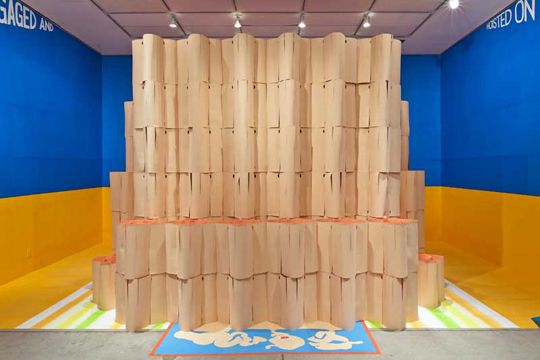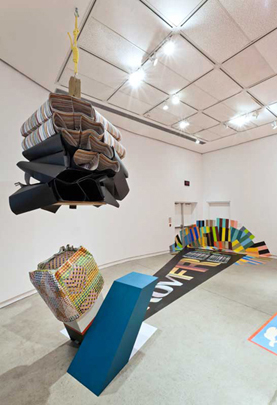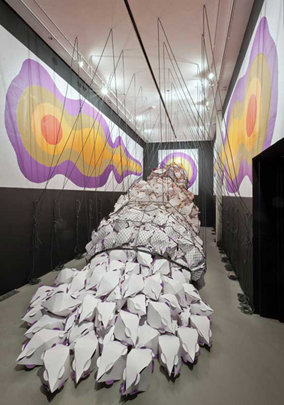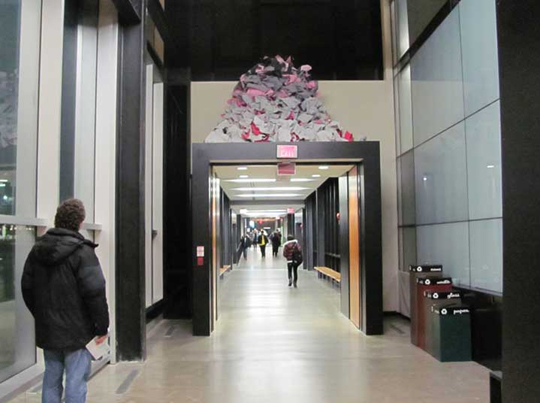
January 18 - March 4, 2012
Curated by Christof Migone





Opening Reception:
Wednesday January 18, 5 - 9pm
A FREE shuttle bus departs from OCADU (100 McCaul St.) at 6:30pm, returns for 9pm.
Artist Talk at Sheridan College
Thursday January 19, 12:30 to 1:30pm
Annie Smith Arts Centre Mezzanine
Sheridan College
1430 Trafalgar Road, Oakville
FREE Contemporary Art Bus Tour
Sunday, February 26, 12 to 5pm
Tour starts at noon at 80 Spadina Ave with the Koffler Gallery Off-Site exhibition, and then departs for Blackwood Gallery, Art Gallery of York University and Doris McCarthy Gallery. To make a reservation, contact the Blackwood Gallery at 905-828-3789 or blackwood.gallery@utoronto.ca by Friday February 24.
The Blackwood Talks: Seripop
Friday March 2, 1 to 3pm
Location: Blackwood Gallery (Kaneff Center)
With Tammer El-Sheikh, Ron Loranger, Christof Migone, Lisa Neighbour
ARTBus Tour
Sunday March 4, 11:30am to 5pm
The bus departs from the Gladstone Hotel (1214 Queen St. W, Toronto) at 11:30am for the Art Gallery of Mississauga, Blackwood Gallery and Burlington Art Centre. To make a reservation, please contact Jaclyn Qua-Hiansen (AGM) at 905 896 5088 or email jaclyn.qua-hiansen@mississauga.ca by Friday, March 2nd.
Join us for a round-table discussion on Seripop's current exhibition Landscapes events reproducted with Tammer El-Sheikh, Ron Loranger, Christof Migone and Lisa Neighbour.
Friday March 2, 1 to 3pm
Location: Blackwood Gallery (Kaneff Center, UTM)
This event is FREE and open to the public.
The Blackwood Talks are a series of public lectures by curators, artists and other scholars that extend the conversation initiated by current gallery exhibitions. The focus of this round-table is the first major solo exhibition by Seripop, the Montreal-based artist duo of Yannick Desranleau and Chloe Lum.
PANELISTS
Tammer El-Sheikh is a PhD candidate in the Department of Art History and Communications Studies at McGill University in Montreal. He received his BA (Philosophy, Art History) from the University of Toronto and his MA (Art History) from Concordia University. He is currently writing his dissertation on the reception of Palestinian-American critic Edward Said within the discipline of art history since the 1970s. The dissertation will ultimately evaluate Said’s strategies of post-colonial critique through case studies of selected contemporary Egyptian art and curatorial practices. Mr. El-Sheikh’s writing on contemporary art and cultural politics has been published in the Canadian periodicals Parachute, C Magazine, Canadian Art and ETC, and internationally in exhibition catalogues produced by the Kunsthalle Wien.
Ron Loranger is a Toronto based Franco-Ontarian visual artist and sometimes curator. Steeped in the artist-run centre community he sits on the programming committee of Le Laboratoire d'art and FAAS (La foire d'art alternative de Sudbury) put on by La galerie du Nouvel-Ontario where he also is on the executive council. Having shown mostly in and around Toronto with art collectives, in public interventions as well with public and private galleries, his work can be found in private collections throughout North America and Europe. He will be showing his first large scale series of watercolours this winter in a solo show at Glendon Gallery, Glendon College York University.
Christof Migone is an artist, curator and writer. He co-edited the book and CD Writing Aloud: The Sonics of Language (Los Angeles: Errant Bodies Press, 2001) and his writings have been published in Aural Cultures, S:ON, Experimental Sound & Radio, Musicworks, Radio Rethink, Semiotext(e), Angelaki, Esse, Inter, Performance Research, etc. He obtained an MFA from NSCAD in 1996 and a PhD from the Department of Performance Studies at the Tisch School of the Arts of New York University in 2007. A monograph on his work, Sound Voice Perform, was published in 2005. In 2006, the Galerie de l’UQAM in Montreal presented a mid-career survey of his work accompanied by a catalog and a DVD entitled Trou. He currently lives in Toronto and is a Lecturer in the Department of Visual Studies at the University of Toronto Mississauga and the Director/Curator of the Blackwood Gallery.
Lisa Neighbour was born in Montreal and now lives and works in Toronto. She graduated from the Ontario College of Art and Design (General Studies, 1982), and received an MFA from York University in 2009. She exhibits with Persona Volare, a collective of Toronto-based installation and media artists, and is represented by Katharine Mulherin Contemporary Art in Toronto. Lisa Neighbour is presently a member of the faculty of the Art and Art History Program, a joint program between Sheridan College and UTM.
Speech is an edifice built out of blocks of space. Words do not exist;
there are only movements in space and their parts—points and areas.
- Velimir Khlebnikov (1)
The power of time is always accompanied by the event which destroys it.
- Georges Didi-Huberman (2)
In Seripop's first major solo exhibition the duo of Yannick Desranleau and Chloe Lum shape posters into immersive ephemeral spaces; transform the galleries into ur-urban landscapes—Kurt Schwitters' Ursonate rendered into form, nod also to his Merzbau; layer proto-messages of agrammatical gibberish—the word reproducted doesn't exist, but is close enough to recognizable to cause confusion, this opens the door to the other instances of written glossolalia throughout the work; manifest a distaste for Le Corbusier's sterile modernism—Le Corbusier is both the villain and the reference; play with possibilities until monomania sets in—once the idea has been tested and tweaked, stick the repro machine on repeat and see what the abundance produces; cover the white cube and the black box with repetitive patterns of noise print—minimalism in the shape of maximalism; trace the viewers' erosive steps—put art on the floor and force the viewer to trample the commodity and thereby ruin it; sculpt with soft materials—the fragility of paper suggests a playful craft-based skill rather than one predicated on a mastery indexed by perennial Classicism; ink flows and fluxes—committing ink to paper is not as stable as the Law would profess, Seripop refuses to sign; structure an erratic conversation—dialogue, yes; conclusion, no; reconstruct constructivism with a punk ethos; reference the streets of a dystopian Montreal—post-Drapeau, post-Expo '67, post-Referenda, post-post; devise DIY architecture as a place where the local is everywhere—be simultaneously specific and general; compose palimpsestic texts to read time into space; poster in three dimensions; map askew—a cartographer's nightmare; savor pleonastic tendencies—verbose run rampant; mine the sinuous—ouroboros curves; pupullate forms; screen the cinematic into stilled installations; occupy every inch of space like space gluttons; concrete amorphous abstraction; relish in operose excess; whelm over and over—overoverwhelm; differentiate between background and foreground no longer—flat depth; fester the synaptic firings until they splatter the walls floors and ceilings—out of brain storm; disturb and derange 2d into 3d; synchronize symmetries while causing head tilts—using visual dissonance in order to break expectations; and inject structure with improvisatory tears and rips—plan to unplan. In short, the Blackwood Gallery is proud to present Landscapes events reproducted.
We collaborate to create immersive screenprinted paper installations. Our work is based on our previous research on posters as topographical markers and their relation with their physical and human environment. We try to playfully relate to these notions through a formal game with the poster where the concepts of space, human intervention within the urban milieu, and material durability are put back in question. Through color, we suggest new volumes or dramatize existing depths; by using paper, we create impressions of massiveness through the paradoxical use of a delicate material; by using the typographic elements introduced by the poster, we give or substract meaning to the whole installation. The works we create are not limited to a formal exploration within the medium. They carry multiple streams of thought that are simultaneously exposed within the work at different degrees of readability for the viewer. This amalgamation of ideas is inevitable because of the collaborative work situation we are in. In fact, we usually leave these ideas uncensored, and even highlight them through a strongly graphic rendering, a heritage from our design antecedents. Therefore we let literary quotes, reflexions about the aesthetics of failure, satyrical introspections, municipal politics and iconic art giants rub elbows with each other, while supporting freely the main subject that is interpreted in the work. Our installation work is the result of an eight years-long field research in graphic design through postermaking. The observations we made of this poster work within the city environment made us requalify it as a series of public interventions rather than static objects. This thought process was the genesis of our installation work and justifies our involvement with the poster as an environmental medium.
The work we are presenting in this exhibition summarizes many aspects of our current research. The title of the show itself is meant as an ellipsis underlining those strains of thought. Each of those three words points to themes that either initiated the research conducting to the form the pieces took, or related to subjective observations that were made once each piece had taken shape. In "Landscapes" we find a reference to the horizontal arrangement of the elements of the three immersive pieces ("Dis-donc à la grosse de se tasser", "More Time Than Space" and "What Should Have Been And What Would Not"), in the fashion of three-dimensional tableaux that suggest flatness despite their depth, quoting in a quasi abstract way the human environment and its classical representation in state of stasis. Also, in "Landscapes" we intended to illustrate semantic elements within the works that are not linked to pure formal/compositional play. For instance, in "Chandigarh Is One" we take the reference to Le Corbusier's intent within his architectural work and to the mid 20th century modernist urban planning (with a quick jab at our situation within Mississauga), and in "Dis-donc à la grosse de se tasser" we use a sentence from Herman Melville's "Moby Dick" as a metaphor of conquest of spatial entities of all forms by man. Serving as a diametrical opposite to "Landscapes", "Events" refers to instances of movement within the works themselves, either materialized by logical/illogical linkings displayed according to the traditional western reading direction, the use of onomatopeias as objects mirroring those linkings in a textual way, or the perceptual games found in immersive colorfields. These are events of stasis that trump stasis itself, or reveal movement albeit being alike to the pace of a snail: the paper that forms the elements of the installations gets either crushed onto itself, wiped or torn off under the feet of the visitors at an infinitesimal speed. "Reproducted" is not an english word, and thus brings the textual staccato that renders the title as an opened sentence suggesting comic relief and the non-finite within our work. Its awkwardness is meant to suggest the capacity of adaptation brought by the modularity of the medium we use that voids any application of definition of specificity to the spaces the works co-habit —and therefore plasticises part of the way the work is read by the viewer.
Yannick Desranleau and Chloe Lum have worked together since 2000 and started the Seripop project in 2002. They have exhibited and given talks in Canada and abroad, notably at BALTIC Centre for Contemporary Art in Gateshead, England, Peacock Visual Arts in Aberdeen, Scotland, Kunsthalle Wien in Vienna, Austria and University of North Texas in Denton. They were recently part of the Quebec Triennial 2011 at Musée d’Art Contemporain de Montréal. Their work is represented in the collection of the Victoria and Albert Museum in London. Lum and Desranleau also belong to Avant-Rock trio AIDS Wolf. More info on their site: seripop.com.
Generously supported by the Canada Council for the Arts and the Student Housing and Residence Life at the University of Toronto Mississauga.
The artists would like to thank the Conseil des arts et des lettres du Québec, the Musée d'art contemporain de Montréal and Harvey Lev.
